Reflective Assessment on Leadership, Management Styles, Change
VerifiedAdded on 2023/06/11
|15
|4413
|79
Report
AI Summary
This assignment presents a reflective assessment of leadership and management styles, focusing on the application of democratic management within a team setting and its impact on achieving goals. It delves into the theories of change management, particularly Lewin's three-step model (unfreeze, change, refreeze), and discusses their practical implementation within a group project. The assessment further explores the principles of effective decision-making, highlighting the importance of adapting management styles to foster innovation and improvement. The student reflects on their personal development and understanding of leadership and management concepts throughout the semester, supported by relevant academic literature and references. Desklib provides students access to similar solved assignments.
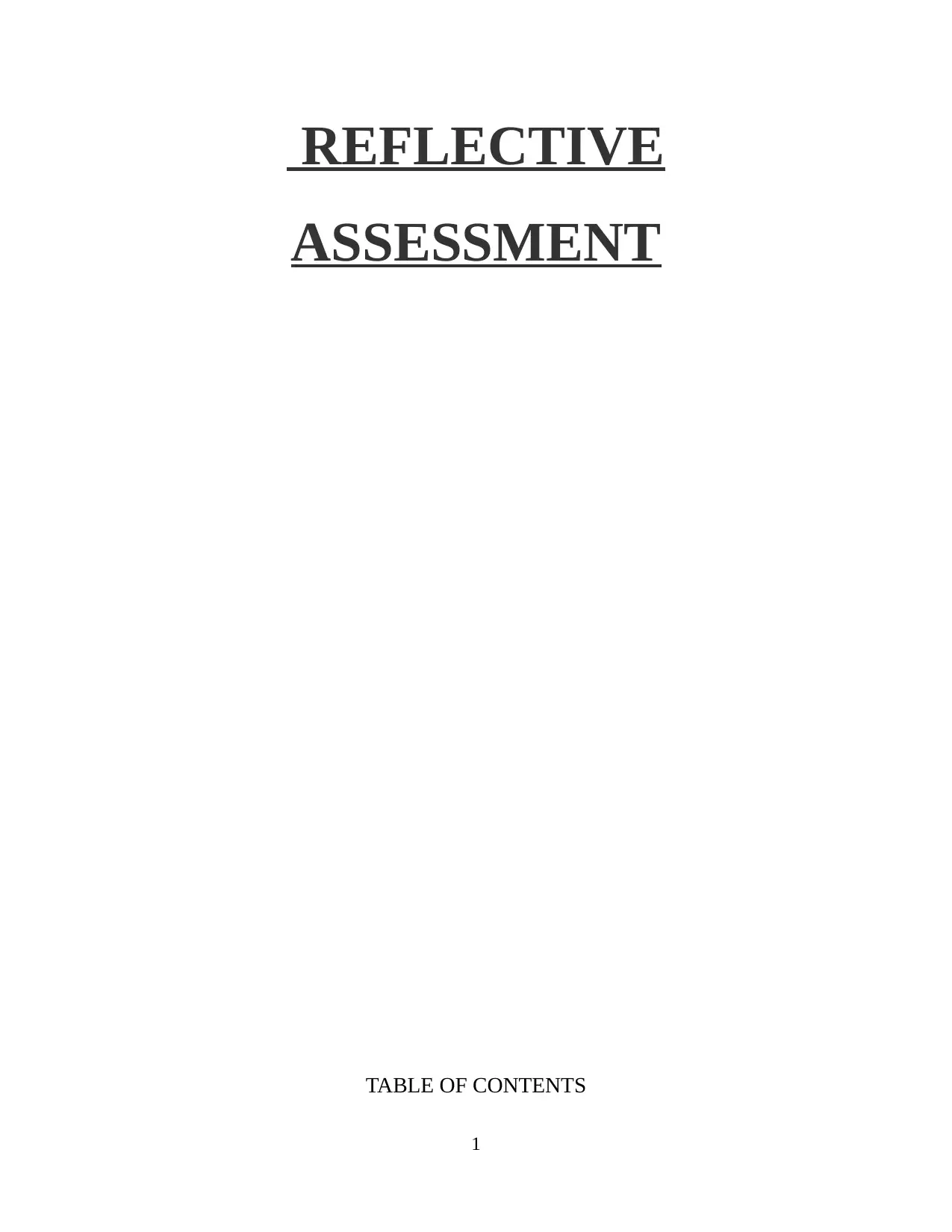
REFLECTIVE
ASSESSMENT
TABLE OF CONTENTS
1
ASSESSMENT
TABLE OF CONTENTS
1
Paraphrase This Document
Need a fresh take? Get an instant paraphrase of this document with our AI Paraphraser
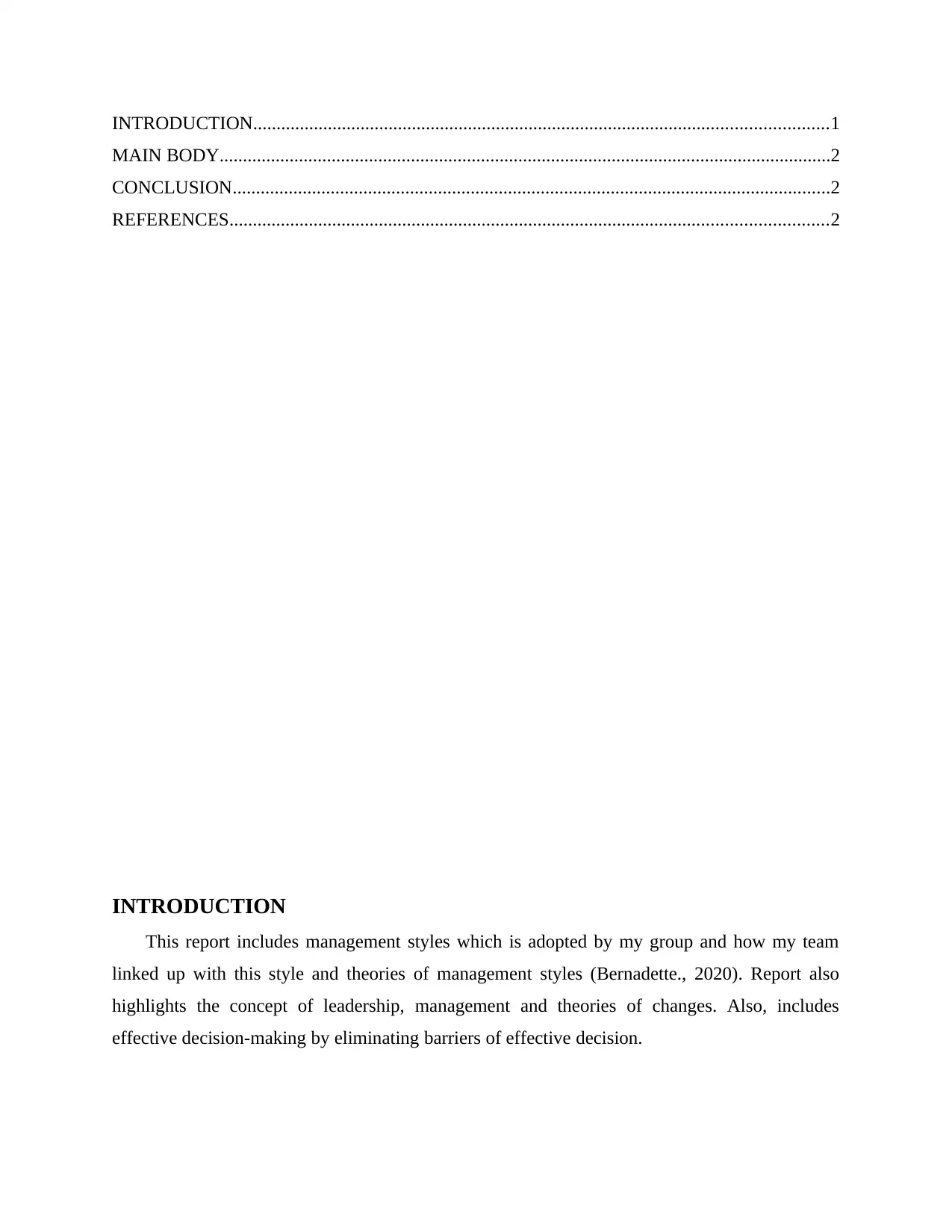
INTRODUCTION...........................................................................................................................1
MAIN BODY...................................................................................................................................2
CONCLUSION................................................................................................................................2
REFERENCES................................................................................................................................2
INTRODUCTION
This report includes management styles which is adopted by my group and how my team
linked up with this style and theories of management styles (Bernadette., 2020). Report also
highlights the concept of leadership, management and theories of changes. Also, includes
effective decision-making by eliminating barriers of effective decision.
MAIN BODY...................................................................................................................................2
CONCLUSION................................................................................................................................2
REFERENCES................................................................................................................................2
INTRODUCTION
This report includes management styles which is adopted by my group and how my team
linked up with this style and theories of management styles (Bernadette., 2020). Report also
highlights the concept of leadership, management and theories of changes. Also, includes
effective decision-making by eliminating barriers of effective decision.
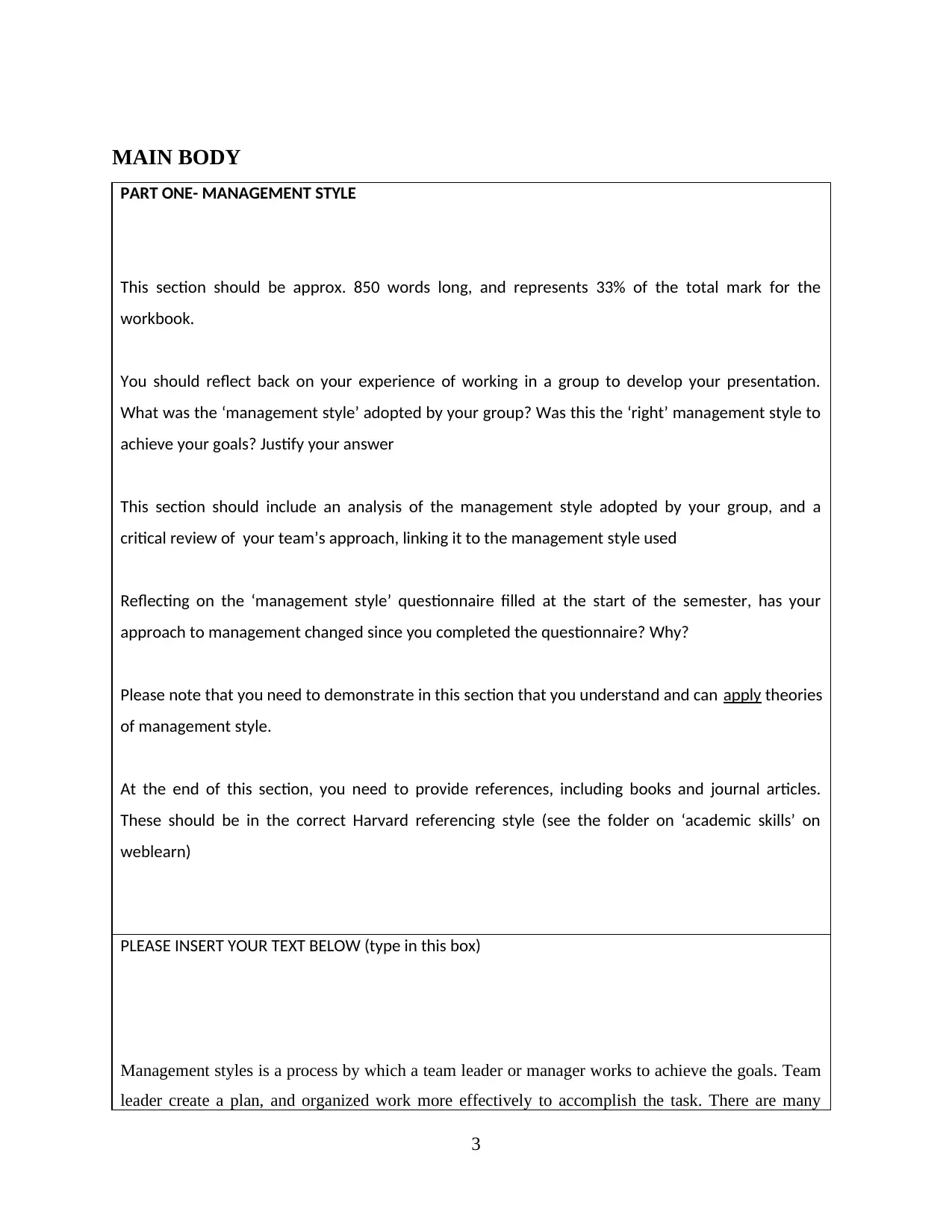
MAIN BODY
PART ONE- MANAGEMENT STYLE
This section should be approx. 850 words long, and represents 33% of the total mark for the
workbook.
You should reflect back on your experience of working in a group to develop your presentation.
What was the ‘management style’ adopted by your group? Was this the ‘right’ management style to
achieve your goals? Justify your answer
This section should include an analysis of the management style adopted by your group, and a
critical review of your team’s approach, linking it to the management style used
Reflecting on the ‘management style’ questionnaire filled at the start of the semester, has your
approach to management changed since you completed the questionnaire? Why?
Please note that you need to demonstrate in this section that you understand and can apply theories
of management style.
At the end of this section, you need to provide references, including books and journal articles.
These should be in the correct Harvard referencing style (see the folder on ‘academic skills’ on
weblearn)
PLEASE INSERT YOUR TEXT BELOW (type in this box)
Management styles is a process by which a team leader or manager works to achieve the goals. Team
leader create a plan, and organized work more effectively to accomplish the task. There are many
3
PART ONE- MANAGEMENT STYLE
This section should be approx. 850 words long, and represents 33% of the total mark for the
workbook.
You should reflect back on your experience of working in a group to develop your presentation.
What was the ‘management style’ adopted by your group? Was this the ‘right’ management style to
achieve your goals? Justify your answer
This section should include an analysis of the management style adopted by your group, and a
critical review of your team’s approach, linking it to the management style used
Reflecting on the ‘management style’ questionnaire filled at the start of the semester, has your
approach to management changed since you completed the questionnaire? Why?
Please note that you need to demonstrate in this section that you understand and can apply theories
of management style.
At the end of this section, you need to provide references, including books and journal articles.
These should be in the correct Harvard referencing style (see the folder on ‘academic skills’ on
weblearn)
PLEASE INSERT YOUR TEXT BELOW (type in this box)
Management styles is a process by which a team leader or manager works to achieve the goals. Team
leader create a plan, and organized work more effectively to accomplish the task. There are many
3
⊘ This is a preview!⊘
Do you want full access?
Subscribe today to unlock all pages.

Trusted by 1+ million students worldwide
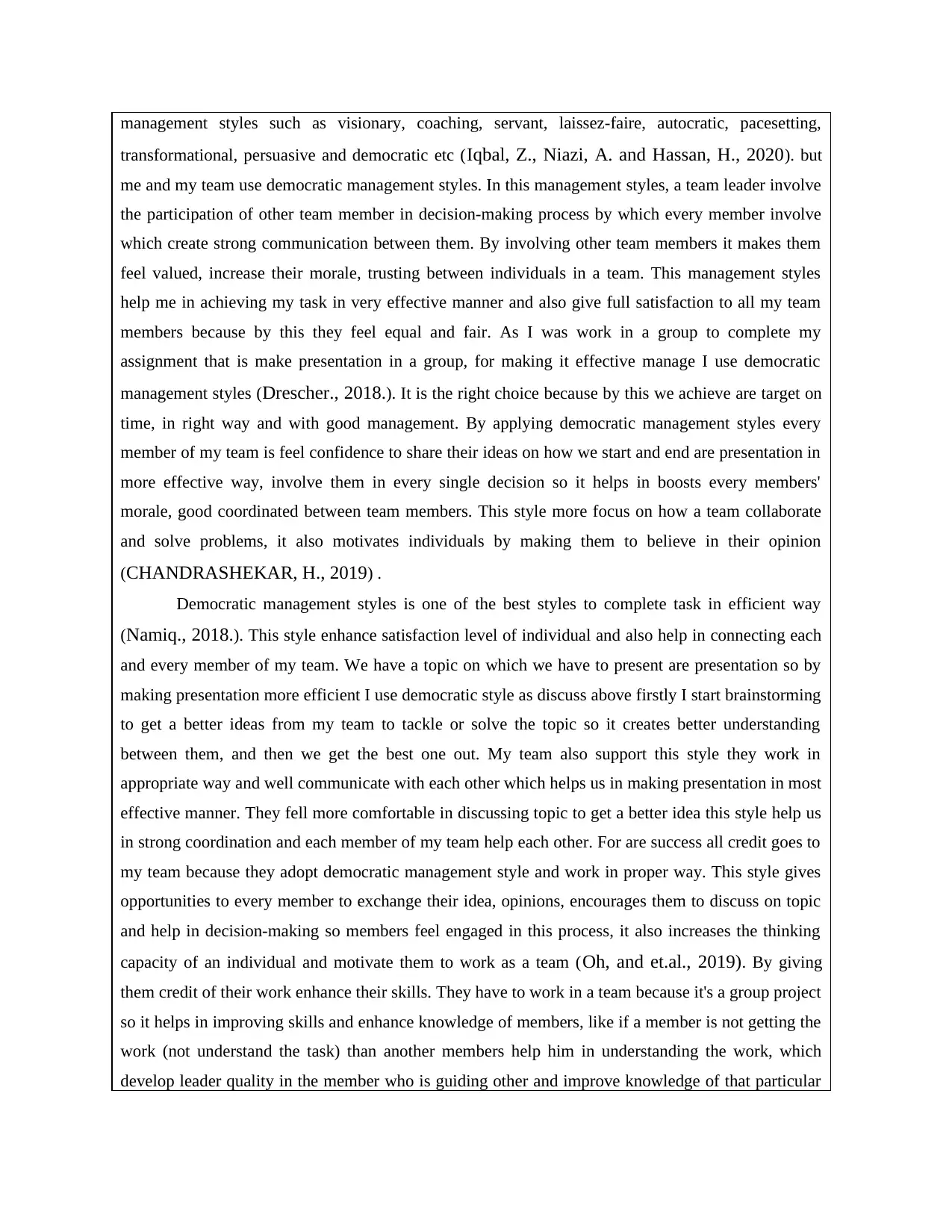
management styles such as visionary, coaching, servant, laissez-faire, autocratic, pacesetting,
transformational, persuasive and democratic etc (Iqbal, Z., Niazi, A. and Hassan, H., 2020). but
me and my team use democratic management styles. In this management styles, a team leader involve
the participation of other team member in decision-making process by which every member involve
which create strong communication between them. By involving other team members it makes them
feel valued, increase their morale, trusting between individuals in a team. This management styles
help me in achieving my task in very effective manner and also give full satisfaction to all my team
members because by this they feel equal and fair. As I was work in a group to complete my
assignment that is make presentation in a group, for making it effective manage I use democratic
management styles (Drescher., 2018.). It is the right choice because by this we achieve are target on
time, in right way and with good management. By applying democratic management styles every
member of my team is feel confidence to share their ideas on how we start and end are presentation in
more effective way, involve them in every single decision so it helps in boosts every members'
morale, good coordinated between team members. This style more focus on how a team collaborate
and solve problems, it also motivates individuals by making them to believe in their opinion
(CHANDRASHEKAR, H., 2019) .
Democratic management styles is one of the best styles to complete task in efficient way
(Namiq., 2018.). This style enhance satisfaction level of individual and also help in connecting each
and every member of my team. We have a topic on which we have to present are presentation so by
making presentation more efficient I use democratic style as discuss above firstly I start brainstorming
to get a better ideas from my team to tackle or solve the topic so it creates better understanding
between them, and then we get the best one out. My team also support this style they work in
appropriate way and well communicate with each other which helps us in making presentation in most
effective manner. They fell more comfortable in discussing topic to get a better idea this style help us
in strong coordination and each member of my team help each other. For are success all credit goes to
my team because they adopt democratic management style and work in proper way. This style gives
opportunities to every member to exchange their idea, opinions, encourages them to discuss on topic
and help in decision-making so members feel engaged in this process, it also increases the thinking
capacity of an individual and motivate them to work as a team (Oh, and et.al., 2019). By giving
them credit of their work enhance their skills. They have to work in a team because it's a group project
so it helps in improving skills and enhance knowledge of members, like if a member is not getting the
work (not understand the task) than another members help him in understanding the work, which
develop leader quality in the member who is guiding other and improve knowledge of that particular
transformational, persuasive and democratic etc (Iqbal, Z., Niazi, A. and Hassan, H., 2020). but
me and my team use democratic management styles. In this management styles, a team leader involve
the participation of other team member in decision-making process by which every member involve
which create strong communication between them. By involving other team members it makes them
feel valued, increase their morale, trusting between individuals in a team. This management styles
help me in achieving my task in very effective manner and also give full satisfaction to all my team
members because by this they feel equal and fair. As I was work in a group to complete my
assignment that is make presentation in a group, for making it effective manage I use democratic
management styles (Drescher., 2018.). It is the right choice because by this we achieve are target on
time, in right way and with good management. By applying democratic management styles every
member of my team is feel confidence to share their ideas on how we start and end are presentation in
more effective way, involve them in every single decision so it helps in boosts every members'
morale, good coordinated between team members. This style more focus on how a team collaborate
and solve problems, it also motivates individuals by making them to believe in their opinion
(CHANDRASHEKAR, H., 2019) .
Democratic management styles is one of the best styles to complete task in efficient way
(Namiq., 2018.). This style enhance satisfaction level of individual and also help in connecting each
and every member of my team. We have a topic on which we have to present are presentation so by
making presentation more efficient I use democratic style as discuss above firstly I start brainstorming
to get a better ideas from my team to tackle or solve the topic so it creates better understanding
between them, and then we get the best one out. My team also support this style they work in
appropriate way and well communicate with each other which helps us in making presentation in most
effective manner. They fell more comfortable in discussing topic to get a better idea this style help us
in strong coordination and each member of my team help each other. For are success all credit goes to
my team because they adopt democratic management style and work in proper way. This style gives
opportunities to every member to exchange their idea, opinions, encourages them to discuss on topic
and help in decision-making so members feel engaged in this process, it also increases the thinking
capacity of an individual and motivate them to work as a team (Oh, and et.al., 2019). By giving
them credit of their work enhance their skills. They have to work in a team because it's a group project
so it helps in improving skills and enhance knowledge of members, like if a member is not getting the
work (not understand the task) than another members help him in understanding the work, which
develop leader quality in the member who is guiding other and improve knowledge of that particular
Paraphrase This Document
Need a fresh take? Get an instant paraphrase of this document with our AI Paraphraser
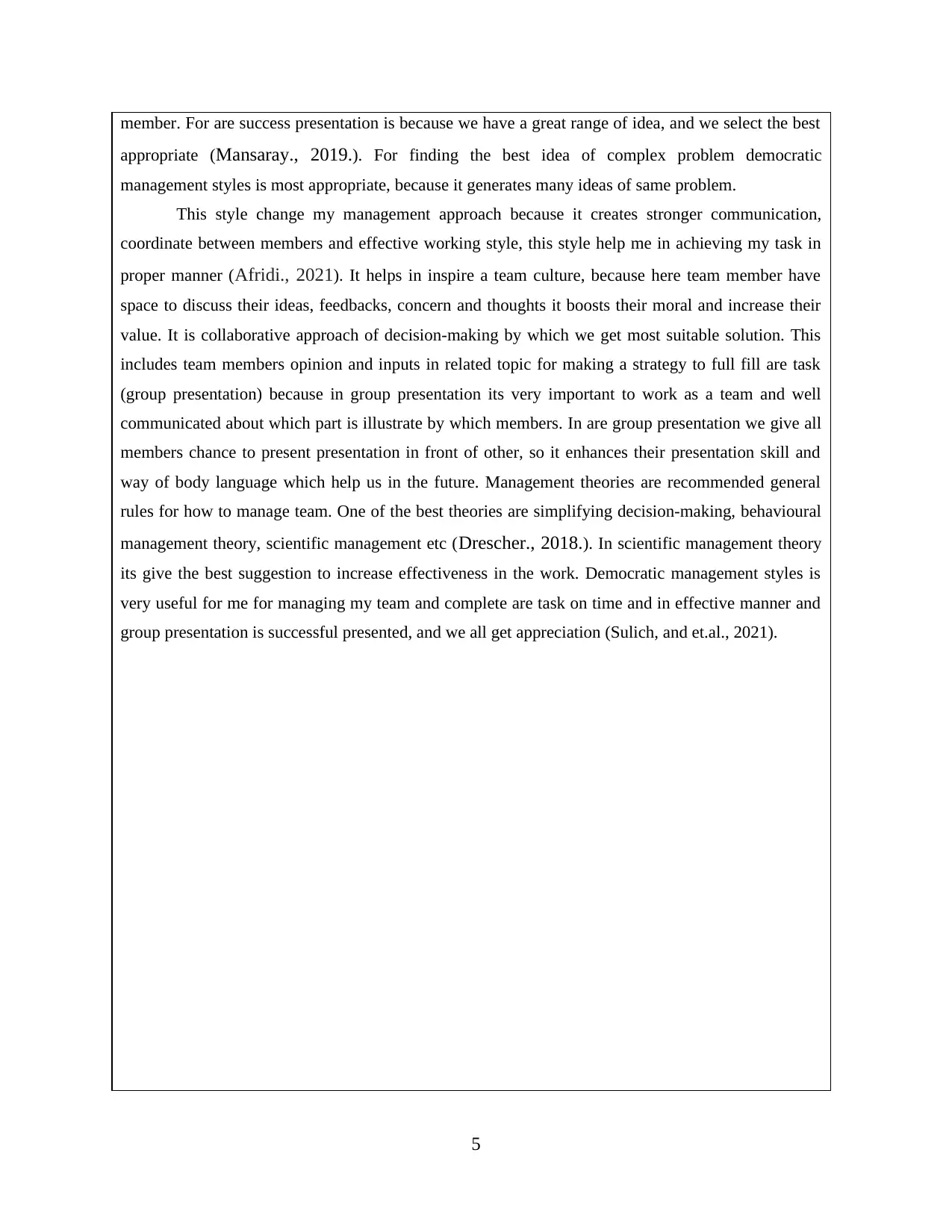
member. For are success presentation is because we have a great range of idea, and we select the best
appropriate (Mansaray., 2019.). For finding the best idea of complex problem democratic
management styles is most appropriate, because it generates many ideas of same problem.
This style change my management approach because it creates stronger communication,
coordinate between members and effective working style, this style help me in achieving my task in
proper manner (Afridi., 2021). It helps in inspire a team culture, because here team member have
space to discuss their ideas, feedbacks, concern and thoughts it boosts their moral and increase their
value. It is collaborative approach of decision-making by which we get most suitable solution. This
includes team members opinion and inputs in related topic for making a strategy to full fill are task
(group presentation) because in group presentation its very important to work as a team and well
communicated about which part is illustrate by which members. In are group presentation we give all
members chance to present presentation in front of other, so it enhances their presentation skill and
way of body language which help us in the future. Management theories are recommended general
rules for how to manage team. One of the best theories are simplifying decision-making, behavioural
management theory, scientific management etc (Drescher., 2018.). In scientific management theory
its give the best suggestion to increase effectiveness in the work. Democratic management styles is
very useful for me for managing my team and complete are task on time and in effective manner and
group presentation is successful presented, and we all get appreciation (Sulich, and et.al., 2021).
5
appropriate (Mansaray., 2019.). For finding the best idea of complex problem democratic
management styles is most appropriate, because it generates many ideas of same problem.
This style change my management approach because it creates stronger communication,
coordinate between members and effective working style, this style help me in achieving my task in
proper manner (Afridi., 2021). It helps in inspire a team culture, because here team member have
space to discuss their ideas, feedbacks, concern and thoughts it boosts their moral and increase their
value. It is collaborative approach of decision-making by which we get most suitable solution. This
includes team members opinion and inputs in related topic for making a strategy to full fill are task
(group presentation) because in group presentation its very important to work as a team and well
communicated about which part is illustrate by which members. In are group presentation we give all
members chance to present presentation in front of other, so it enhances their presentation skill and
way of body language which help us in the future. Management theories are recommended general
rules for how to manage team. One of the best theories are simplifying decision-making, behavioural
management theory, scientific management etc (Drescher., 2018.). In scientific management theory
its give the best suggestion to increase effectiveness in the work. Democratic management styles is
very useful for me for managing my team and complete are task on time and in effective manner and
group presentation is successful presented, and we all get appreciation (Sulich, and et.al., 2021).
5
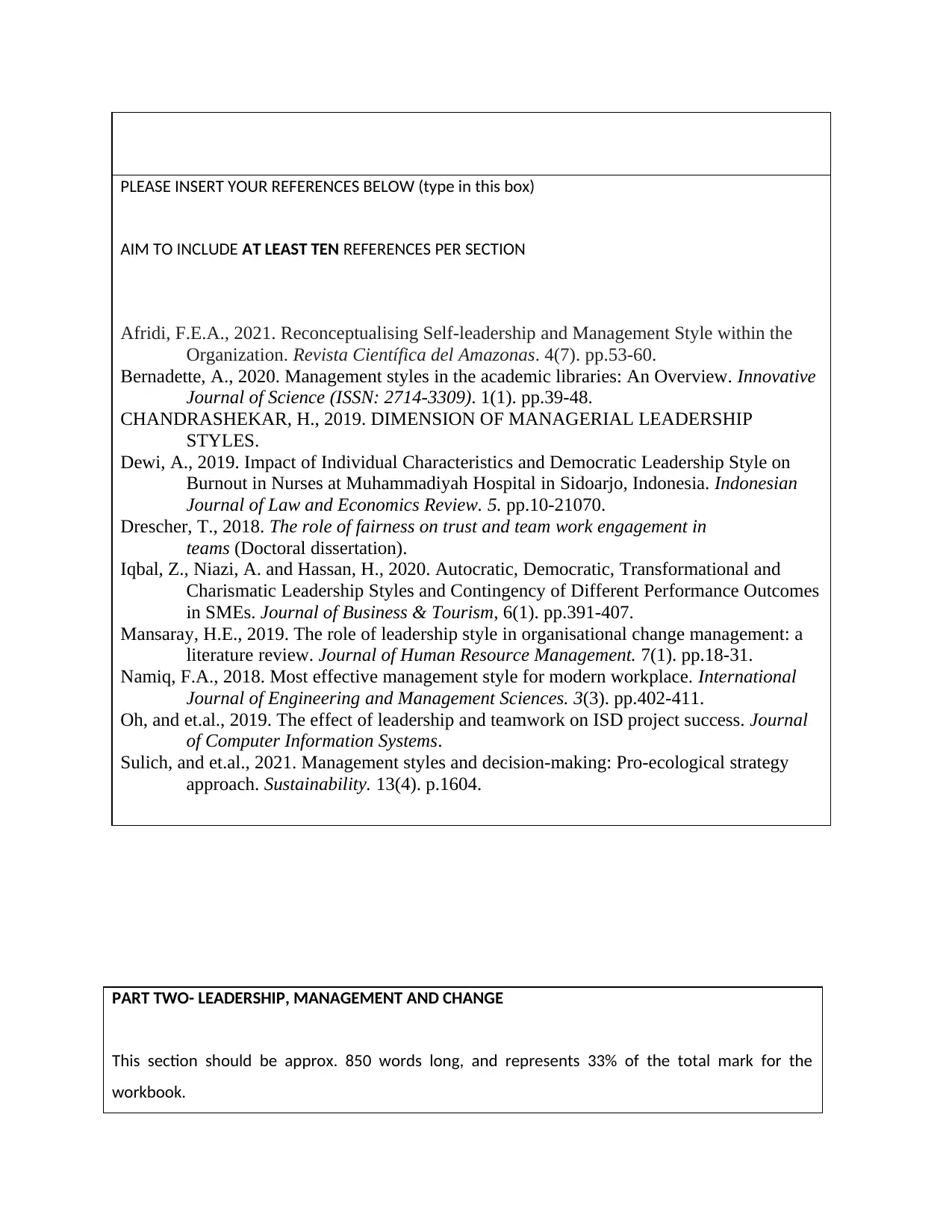
PLEASE INSERT YOUR REFERENCES BELOW (type in this box)
AIM TO INCLUDE AT LEAST TEN REFERENCES PER SECTION
Afridi, F.E.A., 2021. Reconceptualising Self-leadership and Management Style within the
Organization. Revista Científica del Amazonas. 4(7). pp.53-60.
Bernadette, A., 2020. Management styles in the academic libraries: An Overview. Innovative
Journal of Science (ISSN: 2714-3309). 1(1). pp.39-48.
CHANDRASHEKAR, H., 2019. DIMENSION OF MANAGERIAL LEADERSHIP
STYLES.
Dewi, A., 2019. Impact of Individual Characteristics and Democratic Leadership Style on
Burnout in Nurses at Muhammadiyah Hospital in Sidoarjo, Indonesia. Indonesian
Journal of Law and Economics Review. 5. pp.10-21070.
Drescher, T., 2018. The role of fairness on trust and team work engagement in
teams (Doctoral dissertation).
Iqbal, Z., Niazi, A. and Hassan, H., 2020. Autocratic, Democratic, Transformational and
Charismatic Leadership Styles and Contingency of Different Performance Outcomes
in SMEs. Journal of Business & Tourism, 6(1). pp.391-407.
Mansaray, H.E., 2019. The role of leadership style in organisational change management: a
literature review. Journal of Human Resource Management. 7(1). pp.18-31.
Namiq, F.A., 2018. Most effective management style for modern workplace. International
Journal of Engineering and Management Sciences. 3(3). pp.402-411.
Oh, and et.al., 2019. The effect of leadership and teamwork on ISD project success. Journal
of Computer Information Systems.
Sulich, and et.al., 2021. Management styles and decision-making: Pro-ecological strategy
approach. Sustainability. 13(4). p.1604.
PART TWO- LEADERSHIP, MANAGEMENT AND CHANGE
This section should be approx. 850 words long, and represents 33% of the total mark for the
workbook.
AIM TO INCLUDE AT LEAST TEN REFERENCES PER SECTION
Afridi, F.E.A., 2021. Reconceptualising Self-leadership and Management Style within the
Organization. Revista Científica del Amazonas. 4(7). pp.53-60.
Bernadette, A., 2020. Management styles in the academic libraries: An Overview. Innovative
Journal of Science (ISSN: 2714-3309). 1(1). pp.39-48.
CHANDRASHEKAR, H., 2019. DIMENSION OF MANAGERIAL LEADERSHIP
STYLES.
Dewi, A., 2019. Impact of Individual Characteristics and Democratic Leadership Style on
Burnout in Nurses at Muhammadiyah Hospital in Sidoarjo, Indonesia. Indonesian
Journal of Law and Economics Review. 5. pp.10-21070.
Drescher, T., 2018. The role of fairness on trust and team work engagement in
teams (Doctoral dissertation).
Iqbal, Z., Niazi, A. and Hassan, H., 2020. Autocratic, Democratic, Transformational and
Charismatic Leadership Styles and Contingency of Different Performance Outcomes
in SMEs. Journal of Business & Tourism, 6(1). pp.391-407.
Mansaray, H.E., 2019. The role of leadership style in organisational change management: a
literature review. Journal of Human Resource Management. 7(1). pp.18-31.
Namiq, F.A., 2018. Most effective management style for modern workplace. International
Journal of Engineering and Management Sciences. 3(3). pp.402-411.
Oh, and et.al., 2019. The effect of leadership and teamwork on ISD project success. Journal
of Computer Information Systems.
Sulich, and et.al., 2021. Management styles and decision-making: Pro-ecological strategy
approach. Sustainability. 13(4). p.1604.
PART TWO- LEADERSHIP, MANAGEMENT AND CHANGE
This section should be approx. 850 words long, and represents 33% of the total mark for the
workbook.
⊘ This is a preview!⊘
Do you want full access?
Subscribe today to unlock all pages.

Trusted by 1+ million students worldwide
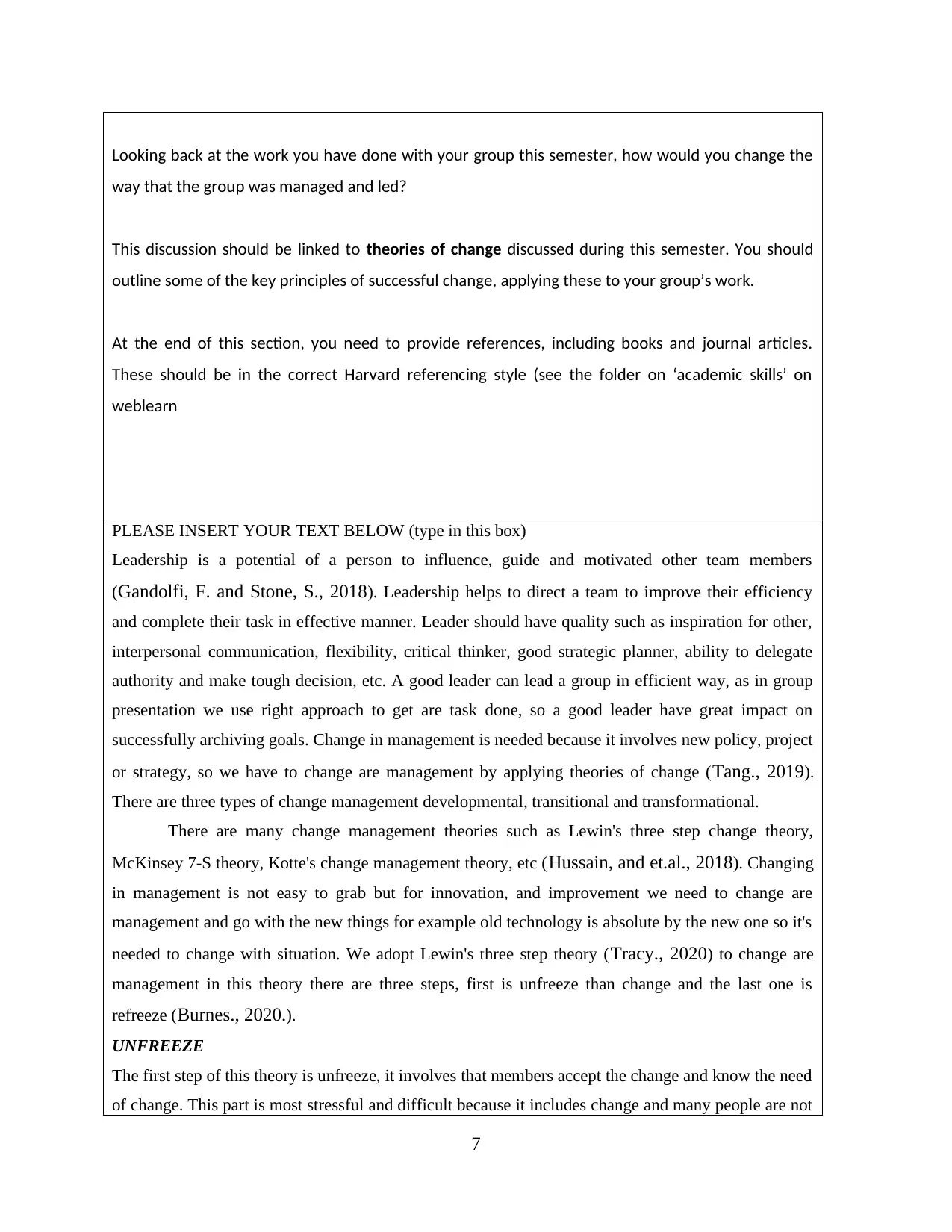
Looking back at the work you have done with your group this semester, how would you change the
way that the group was managed and led?
This discussion should be linked to theories of change discussed during this semester. You should
outline some of the key principles of successful change, applying these to your group’s work.
At the end of this section, you need to provide references, including books and journal articles.
These should be in the correct Harvard referencing style (see the folder on ‘academic skills’ on
weblearn
PLEASE INSERT YOUR TEXT BELOW (type in this box)
Leadership is a potential of a person to influence, guide and motivated other team members
(Gandolfi, F. and Stone, S., 2018). Leadership helps to direct a team to improve their efficiency
and complete their task in effective manner. Leader should have quality such as inspiration for other,
interpersonal communication, flexibility, critical thinker, good strategic planner, ability to delegate
authority and make tough decision, etc. A good leader can lead a group in efficient way, as in group
presentation we use right approach to get are task done, so a good leader have great impact on
successfully archiving goals. Change in management is needed because it involves new policy, project
or strategy, so we have to change are management by applying theories of change (Tang., 2019).
There are three types of change management developmental, transitional and transformational.
There are many change management theories such as Lewin's three step change theory,
McKinsey 7-S theory, Kotte's change management theory, etc (Hussain, and et.al., 2018). Changing
in management is not easy to grab but for innovation, and improvement we need to change are
management and go with the new things for example old technology is absolute by the new one so it's
needed to change with situation. We adopt Lewin's three step theory (Tracy., 2020) to change are
management in this theory there are three steps, first is unfreeze than change and the last one is
refreeze (Burnes., 2020.).
UNFREEZE
The first step of this theory is unfreeze, it involves that members accept the change and know the need
of change. This part is most stressful and difficult because it includes change and many people are not
7
way that the group was managed and led?
This discussion should be linked to theories of change discussed during this semester. You should
outline some of the key principles of successful change, applying these to your group’s work.
At the end of this section, you need to provide references, including books and journal articles.
These should be in the correct Harvard referencing style (see the folder on ‘academic skills’ on
weblearn
PLEASE INSERT YOUR TEXT BELOW (type in this box)
Leadership is a potential of a person to influence, guide and motivated other team members
(Gandolfi, F. and Stone, S., 2018). Leadership helps to direct a team to improve their efficiency
and complete their task in effective manner. Leader should have quality such as inspiration for other,
interpersonal communication, flexibility, critical thinker, good strategic planner, ability to delegate
authority and make tough decision, etc. A good leader can lead a group in efficient way, as in group
presentation we use right approach to get are task done, so a good leader have great impact on
successfully archiving goals. Change in management is needed because it involves new policy, project
or strategy, so we have to change are management by applying theories of change (Tang., 2019).
There are three types of change management developmental, transitional and transformational.
There are many change management theories such as Lewin's three step change theory,
McKinsey 7-S theory, Kotte's change management theory, etc (Hussain, and et.al., 2018). Changing
in management is not easy to grab but for innovation, and improvement we need to change are
management and go with the new things for example old technology is absolute by the new one so it's
needed to change with situation. We adopt Lewin's three step theory (Tracy., 2020) to change are
management in this theory there are three steps, first is unfreeze than change and the last one is
refreeze (Burnes., 2020.).
UNFREEZE
The first step of this theory is unfreeze, it involves that members accept the change and know the need
of change. This part is most stressful and difficult because it includes change and many people are not
7
Paraphrase This Document
Need a fresh take? Get an instant paraphrase of this document with our AI Paraphraser
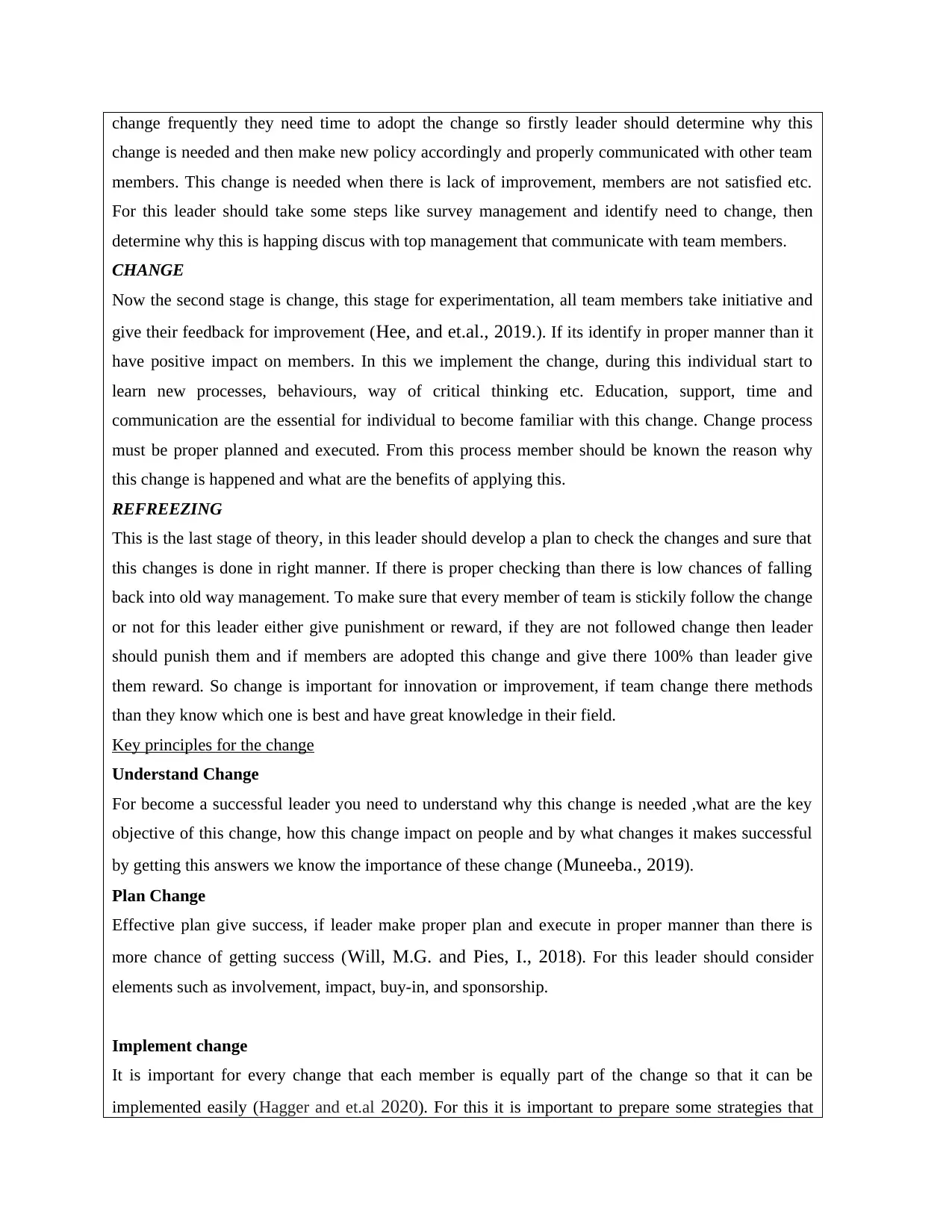
change frequently they need time to adopt the change so firstly leader should determine why this
change is needed and then make new policy accordingly and properly communicated with other team
members. This change is needed when there is lack of improvement, members are not satisfied etc.
For this leader should take some steps like survey management and identify need to change, then
determine why this is happing discus with top management that communicate with team members.
CHANGE
Now the second stage is change, this stage for experimentation, all team members take initiative and
give their feedback for improvement (Hee, and et.al., 2019.). If its identify in proper manner than it
have positive impact on members. In this we implement the change, during this individual start to
learn new processes, behaviours, way of critical thinking etc. Education, support, time and
communication are the essential for individual to become familiar with this change. Change process
must be proper planned and executed. From this process member should be known the reason why
this change is happened and what are the benefits of applying this.
REFREEZING
This is the last stage of theory, in this leader should develop a plan to check the changes and sure that
this changes is done in right manner. If there is proper checking than there is low chances of falling
back into old way management. To make sure that every member of team is stickily follow the change
or not for this leader either give punishment or reward, if they are not followed change then leader
should punish them and if members are adopted this change and give there 100% than leader give
them reward. So change is important for innovation or improvement, if team change there methods
than they know which one is best and have great knowledge in their field.
Key principles for the change
Understand Change
For become a successful leader you need to understand why this change is needed ,what are the key
objective of this change, how this change impact on people and by what changes it makes successful
by getting this answers we know the importance of these change (Muneeba., 2019).
Plan Change
Effective plan give success, if leader make proper plan and execute in proper manner than there is
more chance of getting success (Will, M.G. and Pies, I., 2018). For this leader should consider
elements such as involvement, impact, buy-in, and sponsorship.
Implement change
It is important for every change that each member is equally part of the change so that it can be
implemented easily (Hagger and et.al 2020). For this it is important to prepare some strategies that
change is needed and then make new policy accordingly and properly communicated with other team
members. This change is needed when there is lack of improvement, members are not satisfied etc.
For this leader should take some steps like survey management and identify need to change, then
determine why this is happing discus with top management that communicate with team members.
CHANGE
Now the second stage is change, this stage for experimentation, all team members take initiative and
give their feedback for improvement (Hee, and et.al., 2019.). If its identify in proper manner than it
have positive impact on members. In this we implement the change, during this individual start to
learn new processes, behaviours, way of critical thinking etc. Education, support, time and
communication are the essential for individual to become familiar with this change. Change process
must be proper planned and executed. From this process member should be known the reason why
this change is happened and what are the benefits of applying this.
REFREEZING
This is the last stage of theory, in this leader should develop a plan to check the changes and sure that
this changes is done in right manner. If there is proper checking than there is low chances of falling
back into old way management. To make sure that every member of team is stickily follow the change
or not for this leader either give punishment or reward, if they are not followed change then leader
should punish them and if members are adopted this change and give there 100% than leader give
them reward. So change is important for innovation or improvement, if team change there methods
than they know which one is best and have great knowledge in their field.
Key principles for the change
Understand Change
For become a successful leader you need to understand why this change is needed ,what are the key
objective of this change, how this change impact on people and by what changes it makes successful
by getting this answers we know the importance of these change (Muneeba., 2019).
Plan Change
Effective plan give success, if leader make proper plan and execute in proper manner than there is
more chance of getting success (Will, M.G. and Pies, I., 2018). For this leader should consider
elements such as involvement, impact, buy-in, and sponsorship.
Implement change
It is important for every change that each member is equally part of the change so that it can be
implemented easily (Hagger and et.al 2020). For this it is important to prepare some strategies that
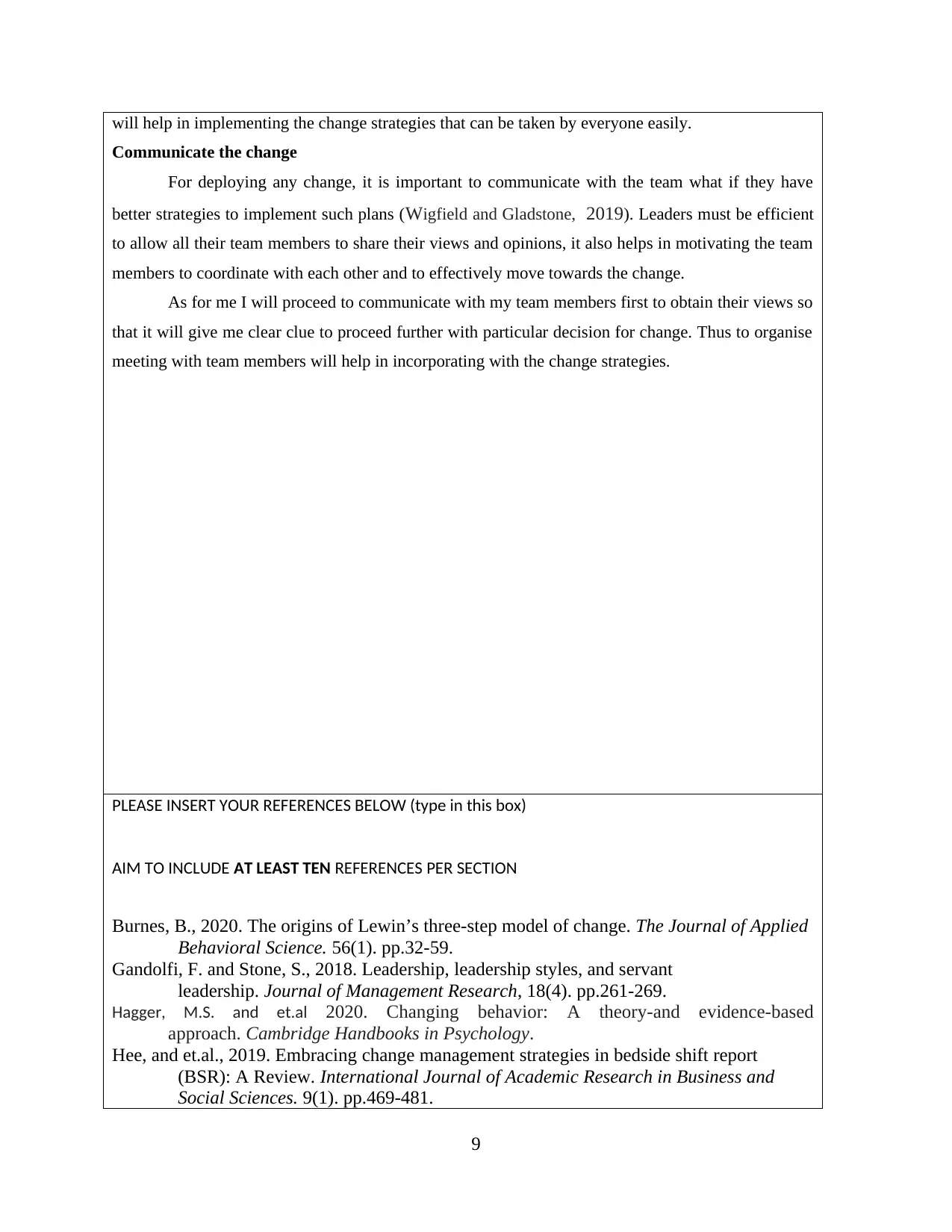
will help in implementing the change strategies that can be taken by everyone easily.
Communicate the change
For deploying any change, it is important to communicate with the team what if they have
better strategies to implement such plans (Wigfield and Gladstone, 2019). Leaders must be efficient
to allow all their team members to share their views and opinions, it also helps in motivating the team
members to coordinate with each other and to effectively move towards the change.
As for me I will proceed to communicate with my team members first to obtain their views so
that it will give me clear clue to proceed further with particular decision for change. Thus to organise
meeting with team members will help in incorporating with the change strategies.
PLEASE INSERT YOUR REFERENCES BELOW (type in this box)
AIM TO INCLUDE AT LEAST TEN REFERENCES PER SECTION
Burnes, B., 2020. The origins of Lewin’s three-step model of change. The Journal of Applied
Behavioral Science. 56(1). pp.32-59.
Gandolfi, F. and Stone, S., 2018. Leadership, leadership styles, and servant
leadership. Journal of Management Research, 18(4). pp.261-269.
Hagger, M.S. and et.al 2020. Changing behavior: A theory-and evidence-based
approach. Cambridge Handbooks in Psychology.
Hee, and et.al., 2019. Embracing change management strategies in bedside shift report
(BSR): A Review. International Journal of Academic Research in Business and
Social Sciences. 9(1). pp.469-481.
9
Communicate the change
For deploying any change, it is important to communicate with the team what if they have
better strategies to implement such plans (Wigfield and Gladstone, 2019). Leaders must be efficient
to allow all their team members to share their views and opinions, it also helps in motivating the team
members to coordinate with each other and to effectively move towards the change.
As for me I will proceed to communicate with my team members first to obtain their views so
that it will give me clear clue to proceed further with particular decision for change. Thus to organise
meeting with team members will help in incorporating with the change strategies.
PLEASE INSERT YOUR REFERENCES BELOW (type in this box)
AIM TO INCLUDE AT LEAST TEN REFERENCES PER SECTION
Burnes, B., 2020. The origins of Lewin’s three-step model of change. The Journal of Applied
Behavioral Science. 56(1). pp.32-59.
Gandolfi, F. and Stone, S., 2018. Leadership, leadership styles, and servant
leadership. Journal of Management Research, 18(4). pp.261-269.
Hagger, M.S. and et.al 2020. Changing behavior: A theory-and evidence-based
approach. Cambridge Handbooks in Psychology.
Hee, and et.al., 2019. Embracing change management strategies in bedside shift report
(BSR): A Review. International Journal of Academic Research in Business and
Social Sciences. 9(1). pp.469-481.
9
⊘ This is a preview!⊘
Do you want full access?
Subscribe today to unlock all pages.

Trusted by 1+ million students worldwide
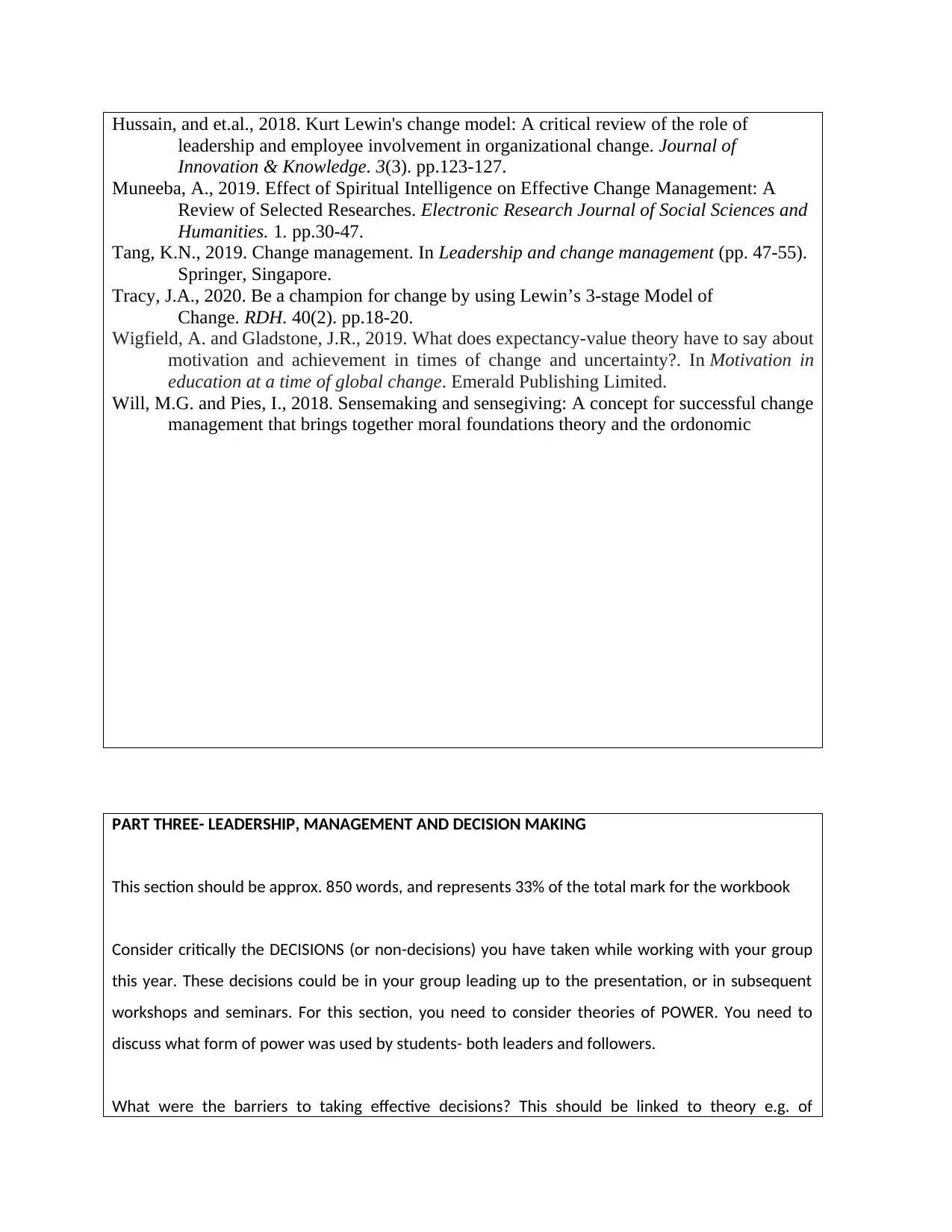
Hussain, and et.al., 2018. Kurt Lewin's change model: A critical review of the role of
leadership and employee involvement in organizational change. Journal of
Innovation & Knowledge. 3(3). pp.123-127.
Muneeba, A., 2019. Effect of Spiritual Intelligence on Effective Change Management: A
Review of Selected Researches. Electronic Research Journal of Social Sciences and
Humanities. 1. pp.30-47.
Tang, K.N., 2019. Change management. In Leadership and change management (pp. 47-55).
Springer, Singapore.
Tracy, J.A., 2020. Be a champion for change by using Lewin’s 3-stage Model of
Change. RDH. 40(2). pp.18-20.
Wigfield, A. and Gladstone, J.R., 2019. What does expectancy-value theory have to say about
motivation and achievement in times of change and uncertainty?. In Motivation in
education at a time of global change. Emerald Publishing Limited.
Will, M.G. and Pies, I., 2018. Sensemaking and sensegiving: A concept for successful change
management that brings together moral foundations theory and the ordonomic
PART THREE- LEADERSHIP, MANAGEMENT AND DECISION MAKING
This section should be approx. 850 words, and represents 33% of the total mark for the workbook
Consider critically the DECISIONS (or non-decisions) you have taken while working with your group
this year. These decisions could be in your group leading up to the presentation, or in subsequent
workshops and seminars. For this section, you need to consider theories of POWER. You need to
discuss what form of power was used by students- both leaders and followers.
What were the barriers to taking effective decisions? This should be linked to theory e.g. of
leadership and employee involvement in organizational change. Journal of
Innovation & Knowledge. 3(3). pp.123-127.
Muneeba, A., 2019. Effect of Spiritual Intelligence on Effective Change Management: A
Review of Selected Researches. Electronic Research Journal of Social Sciences and
Humanities. 1. pp.30-47.
Tang, K.N., 2019. Change management. In Leadership and change management (pp. 47-55).
Springer, Singapore.
Tracy, J.A., 2020. Be a champion for change by using Lewin’s 3-stage Model of
Change. RDH. 40(2). pp.18-20.
Wigfield, A. and Gladstone, J.R., 2019. What does expectancy-value theory have to say about
motivation and achievement in times of change and uncertainty?. In Motivation in
education at a time of global change. Emerald Publishing Limited.
Will, M.G. and Pies, I., 2018. Sensemaking and sensegiving: A concept for successful change
management that brings together moral foundations theory and the ordonomic
PART THREE- LEADERSHIP, MANAGEMENT AND DECISION MAKING
This section should be approx. 850 words, and represents 33% of the total mark for the workbook
Consider critically the DECISIONS (or non-decisions) you have taken while working with your group
this year. These decisions could be in your group leading up to the presentation, or in subsequent
workshops and seminars. For this section, you need to consider theories of POWER. You need to
discuss what form of power was used by students- both leaders and followers.
What were the barriers to taking effective decisions? This should be linked to theory e.g. of
Paraphrase This Document
Need a fresh take? Get an instant paraphrase of this document with our AI Paraphraser
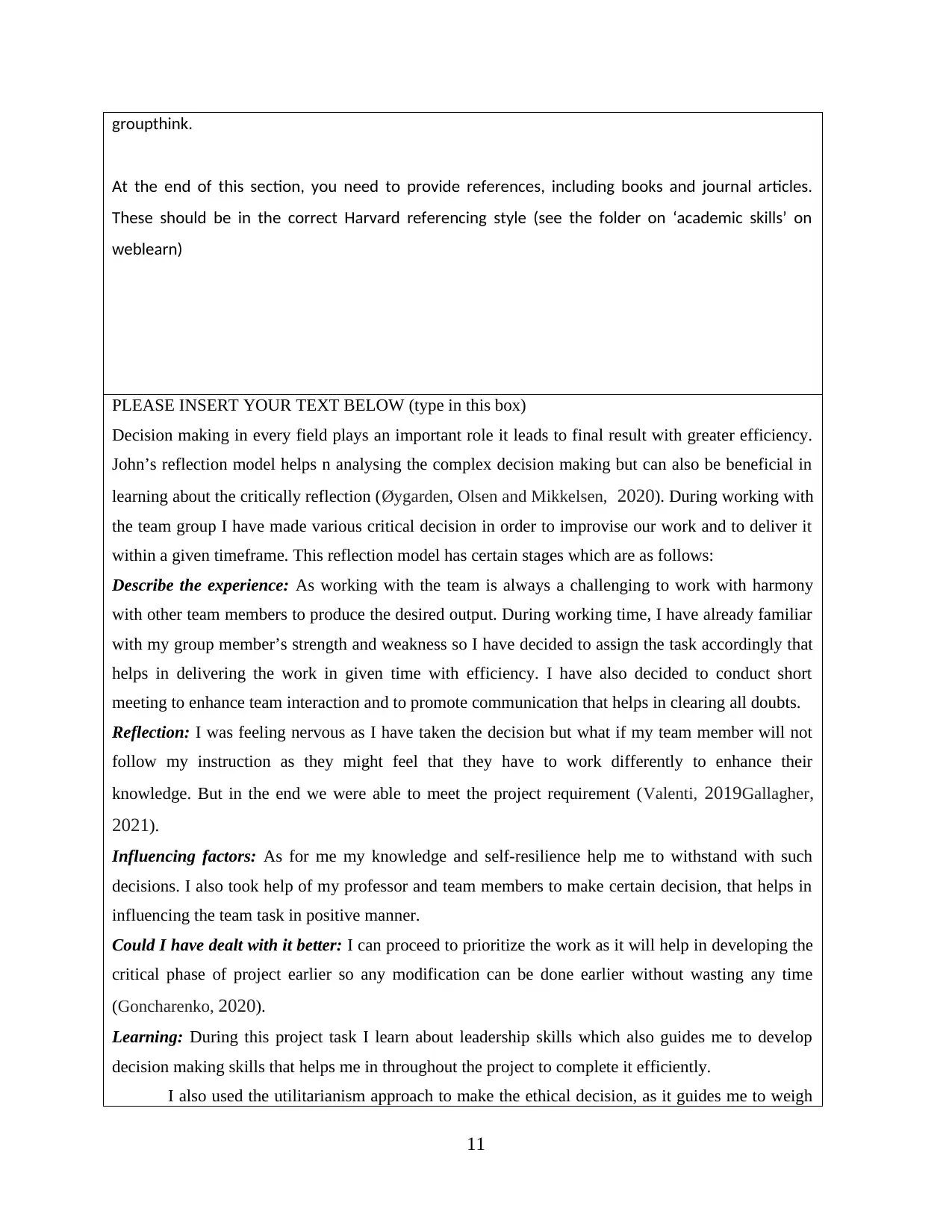
groupthink.
At the end of this section, you need to provide references, including books and journal articles.
These should be in the correct Harvard referencing style (see the folder on ‘academic skills’ on
weblearn)
PLEASE INSERT YOUR TEXT BELOW (type in this box)
Decision making in every field plays an important role it leads to final result with greater efficiency.
John’s reflection model helps n analysing the complex decision making but can also be beneficial in
learning about the critically reflection (Øygarden, Olsen and Mikkelsen, 2020). During working with
the team group I have made various critical decision in order to improvise our work and to deliver it
within a given timeframe. This reflection model has certain stages which are as follows:
Describe the experience: As working with the team is always a challenging to work with harmony
with other team members to produce the desired output. During working time, I have already familiar
with my group member’s strength and weakness so I have decided to assign the task accordingly that
helps in delivering the work in given time with efficiency. I have also decided to conduct short
meeting to enhance team interaction and to promote communication that helps in clearing all doubts.
Reflection: I was feeling nervous as I have taken the decision but what if my team member will not
follow my instruction as they might feel that they have to work differently to enhance their
knowledge. But in the end we were able to meet the project requirement (Valenti, 2019Gallagher,
2021).
Influencing factors: As for me my knowledge and self-resilience help me to withstand with such
decisions. I also took help of my professor and team members to make certain decision, that helps in
influencing the team task in positive manner.
Could I have dealt with it better: I can proceed to prioritize the work as it will help in developing the
critical phase of project earlier so any modification can be done earlier without wasting any time
(Goncharenko, 2020).
Learning: During this project task I learn about leadership skills which also guides me to develop
decision making skills that helps me in throughout the project to complete it efficiently.
I also used the utilitarianism approach to make the ethical decision, as it guides me to weigh
11
At the end of this section, you need to provide references, including books and journal articles.
These should be in the correct Harvard referencing style (see the folder on ‘academic skills’ on
weblearn)
PLEASE INSERT YOUR TEXT BELOW (type in this box)
Decision making in every field plays an important role it leads to final result with greater efficiency.
John’s reflection model helps n analysing the complex decision making but can also be beneficial in
learning about the critically reflection (Øygarden, Olsen and Mikkelsen, 2020). During working with
the team group I have made various critical decision in order to improvise our work and to deliver it
within a given timeframe. This reflection model has certain stages which are as follows:
Describe the experience: As working with the team is always a challenging to work with harmony
with other team members to produce the desired output. During working time, I have already familiar
with my group member’s strength and weakness so I have decided to assign the task accordingly that
helps in delivering the work in given time with efficiency. I have also decided to conduct short
meeting to enhance team interaction and to promote communication that helps in clearing all doubts.
Reflection: I was feeling nervous as I have taken the decision but what if my team member will not
follow my instruction as they might feel that they have to work differently to enhance their
knowledge. But in the end we were able to meet the project requirement (Valenti, 2019Gallagher,
2021).
Influencing factors: As for me my knowledge and self-resilience help me to withstand with such
decisions. I also took help of my professor and team members to make certain decision, that helps in
influencing the team task in positive manner.
Could I have dealt with it better: I can proceed to prioritize the work as it will help in developing the
critical phase of project earlier so any modification can be done earlier without wasting any time
(Goncharenko, 2020).
Learning: During this project task I learn about leadership skills which also guides me to develop
decision making skills that helps me in throughout the project to complete it efficiently.
I also used the utilitarianism approach to make the ethical decision, as it guides me to weigh
11
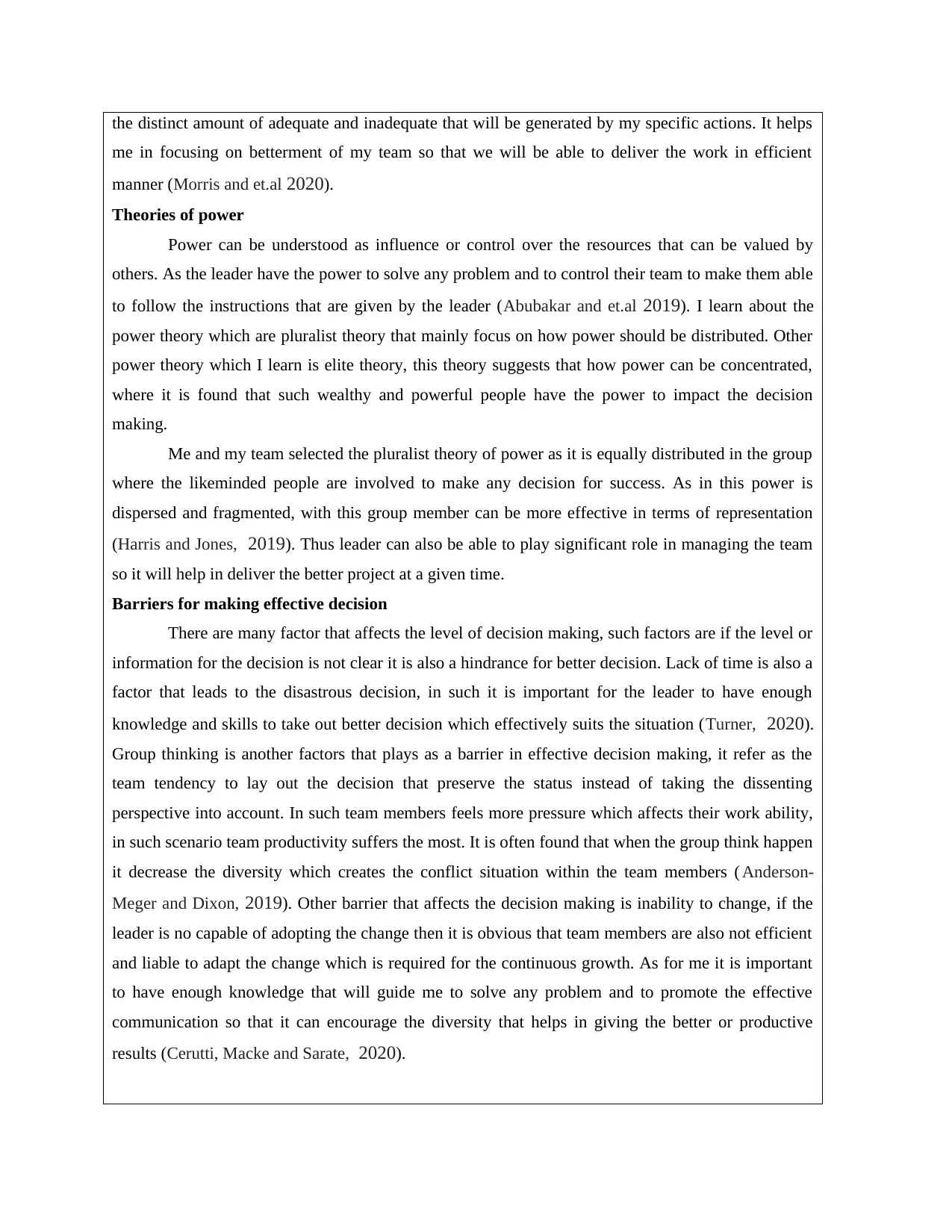
the distinct amount of adequate and inadequate that will be generated by my specific actions. It helps
me in focusing on betterment of my team so that we will be able to deliver the work in efficient
manner (Morris and et.al 2020).
Theories of power
Power can be understood as influence or control over the resources that can be valued by
others. As the leader have the power to solve any problem and to control their team to make them able
to follow the instructions that are given by the leader (Abubakar and et.al 2019). I learn about the
power theory which are pluralist theory that mainly focus on how power should be distributed. Other
power theory which I learn is elite theory, this theory suggests that how power can be concentrated,
where it is found that such wealthy and powerful people have the power to impact the decision
making.
Me and my team selected the pluralist theory of power as it is equally distributed in the group
where the likeminded people are involved to make any decision for success. As in this power is
dispersed and fragmented, with this group member can be more effective in terms of representation
(Harris and Jones, 2019). Thus leader can also be able to play significant role in managing the team
so it will help in deliver the better project at a given time.
Barriers for making effective decision
There are many factor that affects the level of decision making, such factors are if the level or
information for the decision is not clear it is also a hindrance for better decision. Lack of time is also a
factor that leads to the disastrous decision, in such it is important for the leader to have enough
knowledge and skills to take out better decision which effectively suits the situation (Turner, 2020).
Group thinking is another factors that plays as a barrier in effective decision making, it refer as the
team tendency to lay out the decision that preserve the status instead of taking the dissenting
perspective into account. In such team members feels more pressure which affects their work ability,
in such scenario team productivity suffers the most. It is often found that when the group think happen
it decrease the diversity which creates the conflict situation within the team members ( Anderson-
Meger and Dixon, 2019). Other barrier that affects the decision making is inability to change, if the
leader is no capable of adopting the change then it is obvious that team members are also not efficient
and liable to adapt the change which is required for the continuous growth. As for me it is important
to have enough knowledge that will guide me to solve any problem and to promote the effective
communication so that it can encourage the diversity that helps in giving the better or productive
results (Cerutti, Macke and Sarate, 2020).
me in focusing on betterment of my team so that we will be able to deliver the work in efficient
manner (Morris and et.al 2020).
Theories of power
Power can be understood as influence or control over the resources that can be valued by
others. As the leader have the power to solve any problem and to control their team to make them able
to follow the instructions that are given by the leader (Abubakar and et.al 2019). I learn about the
power theory which are pluralist theory that mainly focus on how power should be distributed. Other
power theory which I learn is elite theory, this theory suggests that how power can be concentrated,
where it is found that such wealthy and powerful people have the power to impact the decision
making.
Me and my team selected the pluralist theory of power as it is equally distributed in the group
where the likeminded people are involved to make any decision for success. As in this power is
dispersed and fragmented, with this group member can be more effective in terms of representation
(Harris and Jones, 2019). Thus leader can also be able to play significant role in managing the team
so it will help in deliver the better project at a given time.
Barriers for making effective decision
There are many factor that affects the level of decision making, such factors are if the level or
information for the decision is not clear it is also a hindrance for better decision. Lack of time is also a
factor that leads to the disastrous decision, in such it is important for the leader to have enough
knowledge and skills to take out better decision which effectively suits the situation (Turner, 2020).
Group thinking is another factors that plays as a barrier in effective decision making, it refer as the
team tendency to lay out the decision that preserve the status instead of taking the dissenting
perspective into account. In such team members feels more pressure which affects their work ability,
in such scenario team productivity suffers the most. It is often found that when the group think happen
it decrease the diversity which creates the conflict situation within the team members ( Anderson-
Meger and Dixon, 2019). Other barrier that affects the decision making is inability to change, if the
leader is no capable of adopting the change then it is obvious that team members are also not efficient
and liable to adapt the change which is required for the continuous growth. As for me it is important
to have enough knowledge that will guide me to solve any problem and to promote the effective
communication so that it can encourage the diversity that helps in giving the better or productive
results (Cerutti, Macke and Sarate, 2020).
⊘ This is a preview!⊘
Do you want full access?
Subscribe today to unlock all pages.

Trusted by 1+ million students worldwide
1 out of 15
Related Documents
Your All-in-One AI-Powered Toolkit for Academic Success.
+13062052269
info@desklib.com
Available 24*7 on WhatsApp / Email
![[object Object]](/_next/static/media/star-bottom.7253800d.svg)
Unlock your academic potential
Copyright © 2020–2025 A2Z Services. All Rights Reserved. Developed and managed by ZUCOL.


![Leadership Development Action Plan - [University Name] - [Semester]](/_next/image/?url=https%3A%2F%2Fdesklib.com%2Fmedia%2Fimages%2Fex%2Fca941d1709ed4555af6e8d6457548699.jpg&w=256&q=75)


